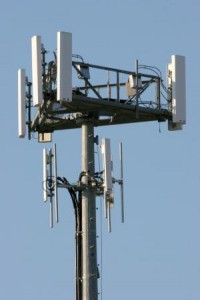 District 150 has found a new way to get revenue: allow private companies to erect cell phone towers on school property.
District 150 has found a new way to get revenue: allow private companies to erect cell phone towers on school property.
In November 2008, the City Council approved a request for U.S. Cellular to erect a cell phone tower at Loucks Edison School (now Thomas Jefferson), 2503 N. University St. Sources tell me the the school district will receive $2000 per month from this lease arrangement, and that more cell towers are planned on other properties, including Whittier School. Putting cell towers on school and church property is common — but controversial — all over the country.
The controversy is over safety. The Federal Communications Commission has several documents regarding cell tower (or “cell site”) radiation levels, and they’ve basically determined that they are very safe. “Measurements made near typical cellular and PCS installations, especially those with tower-mounted antennas, have shown that ground-level power densities are well below limits recommended by RF/microwave safety standards,” says OET [Office of Engineering and Technology] Bulletin 56 (p. 21). Well enough below limits that such cell sites “are considered ‘categorically excluded’ from the requirement for routine environmental processing for RF exposure” by the FCC, according to “A Local Government Official’s Guide to Transmitting Antenna RF Emission Safety.”
Not everyone is convinced. People Against Cell Towers at Schools (PACTS) is an organization started by citizens in Tampa, Florida, that believes cell phone towers should not be placed on or near school playgrounds. They cite a litany of research, including a 2004 article from the American Academy of Pediatrics which stated children are more susceptible to extremely low frequency (ELF) magnetic fields and recommended “additional research and the development of precautionary policies in the face of scientific uncertainty.” In fact, most of the research cited takes a similar approach. For example, the American Cancer Society is quoted as saying, “we do not have full information on health effects… in particular, not enough time has elapsed to permit epidemiological studies.” In other words, exposure to ELF magnetic fields may or may not be dangerous, and until we know for sure, we should limit exposure to children. Furthermore, in response to appeals to the FCC’s report of cell site safety, they say “government agencies have a bad track record in protecting us against long term threats. Think about some of the major oversights in health threats such as tobacco, lead paint, DDT, PCBs and asbestos.”
So far in Peoria, there appears to be little or no concern. The cell tower at the University St. school building had no public opposition. However, that might be because the request went through after the school was closed and before Thomas Jefferson school was relocated there due to the fire at their Florence Avenue facility. The forthcoming request for a cell tower at Whittier will likely be the bellwether of public reaction to the idea.
One other concern that is expressed about cell towers is that they are not exactly aesthetically pleasing. Some communities try to hide them by making them look like trees — seriously. When I was in California last year, I saw a number of cell towers disguised as palm trees. Pictures on Google show towers camouflaged as pine trees, too. Clever, eh?
